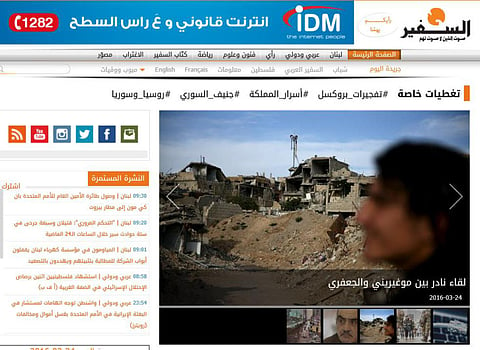After 42 years, leading pan-Arab paper calls it quits
Ten other leading newspapers published in Lebanon are also facing serious financial challenges

Beirut: One of Lebanon’s leading newspaper’s, Al Safir—which boldly displays on its masthead that it is “the newspaper of the Arab world in Lebanon, and the newspaper of Lebanon in the Arab world”—will cease all print and web operations at the end of March, because of serious financial difficulties. It employs 170 personnel.
Although several other newspapers face similar challenges, the pro-Hezbollah daily, is one of two outlets—the other is Al Akhbar—that prides itself for reflecting the views of the so-called resistance movement.
It also leans towards the Syrian Baath regime, as well as other opposition movements across the world, even if its pan-Arab outlook was marginalised after post-2011 revolutions.
Ironically, both Al Safir and Al Akhbar were banned in Syria on July 18, 2011, because of editorials that backed the then peaceful uprisings against Damascus, although the prohibition was lifted some time later after the papers reasserted their pro-Syrian stances.
Currently, ten leading daily newspapers published in Lebanon in three languages (Arabic, English and French), are facing serious financial challenges.
In response, Information Minister Ramzi Joreige, issued a plea calling on the government to salvage the most prominent newspapers.
“We cannot imagine a day when Al Nahar or Al Safir or Al Liwaa are not published anymore,” declared Joreige, adding: “it would be a black day for Lebanon,” where press freedom survived relatively unscathed despite a three-decades long occupation.
Al Safir’s founder and editor, Talal Salman, pledged to hold a press conference on March 30 to provide details on what his plans may be for the paper that was first published on March 26, 1974.
According to a 2013 handbook that examined mass media outlets in the Middle East, Al Safir had a circulation of 45,000 copies in 2003, then the second best-selling paper in Lebanon, and may have reached, according to a 2012 Ministry of Information source, 50,000 copies, which ranked it first during the past few years.
It’s primary rival is Al Nahar, whose 2012 circulation figures stand at 45,000, is also facing a serious financial crisis.
If the paper provided an independent voice to Lebanese and Arab intellectuals in the 1970s, it gradually leaned towards a left-of-centre position and, after the 2005 Cedar Revolution that followed the assassination of Prime Minister Rafik Hariri, towards a solid pro-Syrian stance.
Given its blatant leaning towards pro-Syrian stances, it is unclear why Hezbollah or other allied parties have not yet offered to subsidise the newspaper.
Most dailies in Lebanon sell for 2,000 Lebanese Pounds (about $1.35) which is a high price in a country where average wages are low.
Sign up for the Daily Briefing
Get the latest news and updates straight to your inbox



